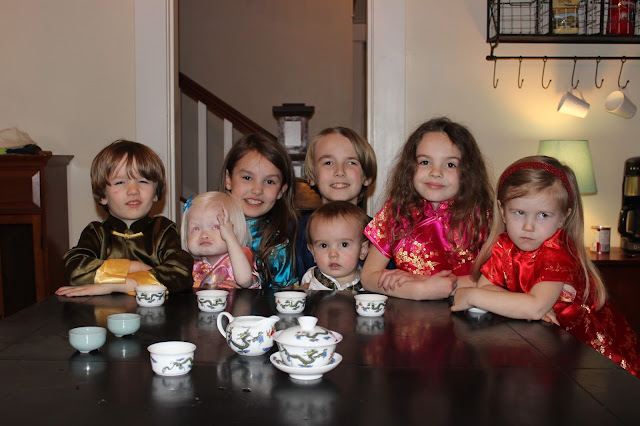In many adoptive situations, families choose to go through a period of time called cocooning. During this time there is very little travel outside the home, life is very low key and stress is kept to a minimum. Imagine that in our household. We are all starting to get cabin fever a bit. There are a lot of us here and we need space to breathe. It is cold and wet outside, so our options are limited. That is a sacrifice that we choose to make for Lottie-Qi. What we hope to gain from this time are the beginnings of lifelong bonds with each of us and a better understanding of our new daughter. We want to know what she likes, what she dislikes, what things cause her stress, what things cause her laughter, what things make her anxious etc. We hope to introduce our personalities to her, while we get to know hers. We want her to grow accustomed to our sounds, our smell, the layout of our home and so many other things that I totally take for granted that all of my children that have been here since birth, already know, find comfort in and call home. We want Lottie to know throughout every fiber of who she is, that she is safe here in our home and in our family. We really do not have a specific amount of time that we plan remain disengaged with the outside world, just whatever it takes for us to begin seeing signs of comfort from our daughter.
Many friends and family do not understand and that is okay. Many children who have been institutionalized crave affection and attention from adults. This will look like running up to total strangers for hugs, snacks and to be held. These simple, sweet gestures seem to show a child that is well adjusted and good tempered, but that is not what these behaviors show at all. They could indicate a child that has no secure bonds to adult figures or manipulation to get needs or desires met. Many children who have been institutionalized DO NOT want any physical touch at all from adults, or any person for that matter. They may have a history of some kind of trauma which creates aversions to various types of sensory stimuli. This could indicate a child who does not feel safe or that has not created trusting bonds with others.
As we go through these days or weeks, or even months. We hope our family and friends understand and support our decisions to create the most healthy environment for our daughter as possible, regardless of what sacrifices must be made. We are essentially starting from the beginning, from the bottom up. And, when she is ready she will emerge from her cocoon.
Beautiful and before God, my life merged with another on a beach in Hawaii the first June afternoon of 2002. That is where our adventure began! Here it continues...
Thursday, February 11, 2016
Monday, February 8, 2016
Chinese New Year 2016: The Year of the Monkey
Chinese New Year, also known as Spring Festival, is a huge tradition in China. So much so, that it brings in the greatest influx of people (mostly Chinese returning to see family) than any other holiday in the country. We got to experience this first hand as we were leaving China as the Chinese New Year was about to begin. We just barely were able to make the trip because all government agencies and most local businesses shut down for the festival. The festival begins on the first day of the lunar calendar, which is the first new moon between January 21 and February 20. This year it began on February 8. We celebrated with a Chinese meal, authentic Chinese tea in a tea set that we picked up from a local market in China, and the customary Chinese attire that we brought home for the kids. We found it amusing that before we ever felt called to adopt, we have always acknowledged the children's Chinese New Year characters from the years that they were born, even commemorating them with a pair of soft soled shoes (Robeez) for each of them as they began walking. We have them stored away with their keepsakes. God always new this was our path.
2016 is the Year of the Monkey.
Subscribe to:
Posts (Atom)





